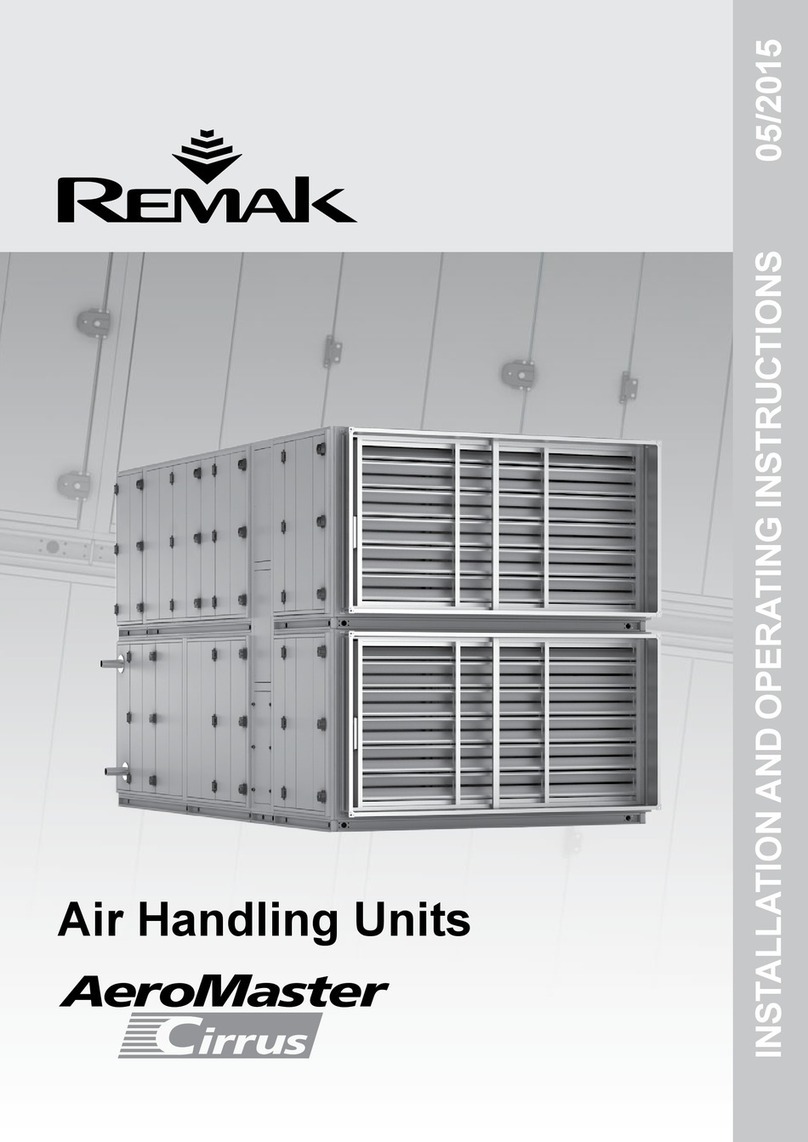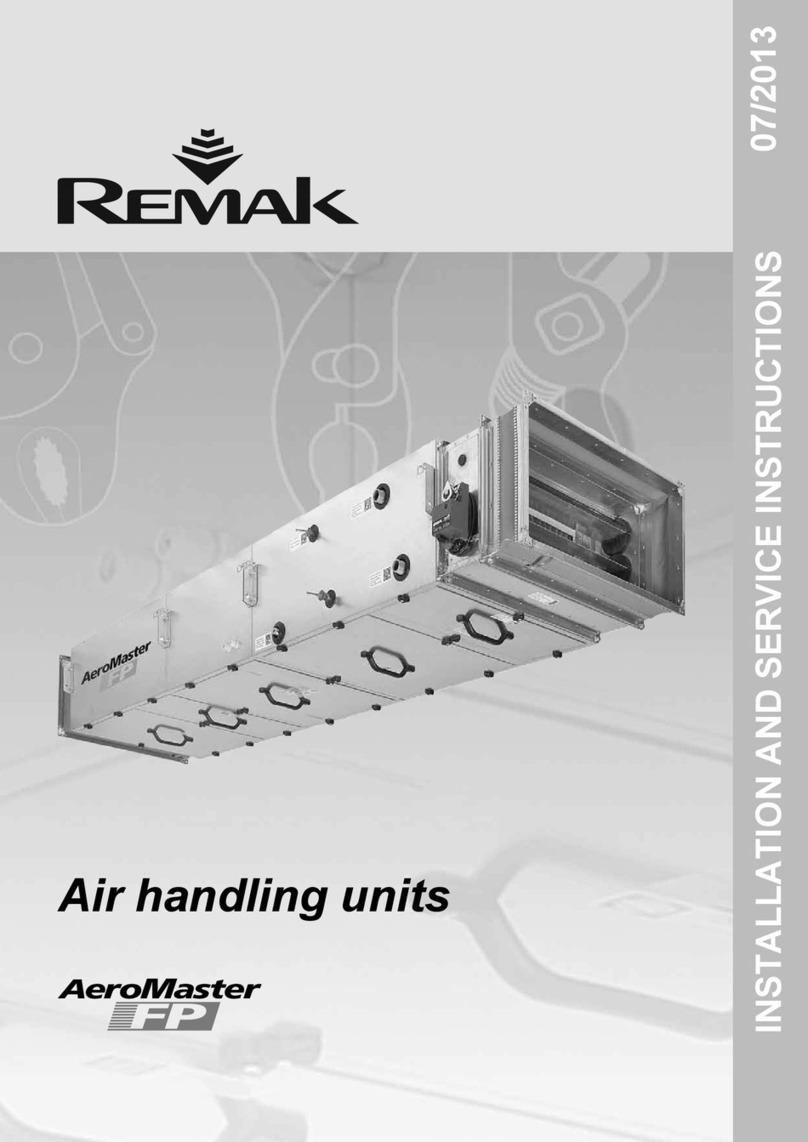
Modular air-handling units, Series X
3
Use and operating conditions, Air-handling unit construction, Packing and transport
Use and operating conditions
REMAK series X air-handling units are designed for
comfortable air-handling and air-conditioning in an air flow
range from 1,000 m3/h to 35,000 m3/h at fan air pressure
difference of up to 2,500 Pa.
They are intended for handling of air without solid, fibrous,
sticky, aggressive, respectively explosive impurities. The air
must be free of corrosive chemicals or chemicals aggressive
to zinc and steel, respectively aluminium.
REMAK series X units are supplied with factory-installed
base-frame and are primarily intended for installation on floor
or steel support construction/frame supplanting the floor.
REMAK series X air-handling units can be used without any
additional measures in normal environments (IEC 60364-
5-51, resp. ČSN 33 2000-5-51 ed. 3, ČSN 33 2000-1 ed.2)
and in rooms with extended ambient temperature ranging
from -40 °C to +40 °C. When selecting the air-handling unit,
it is necessary to take into account the temperature and
humidity of the inlet and outlet air in relation with the ambient
temperature and humidity. It is especially necessary to analyze
the relation of the unit‘s casing classification pursuant to EN
1886 and the risk of condensation, respectively frost deposit.
Ingress protection (objects, water) is IP 44. IP 44 protection
level does not refer to accessories and control components
(they must be assessed separately based on their particular
documentation).
The unit equipped with the outdoor roof is water spray proof
(rain up to 60° from vertical) and providing the particular
instructions specified further are followed, the unit can be
used outdoors.
Air-handling unit construction
Unit construction is modular with casing consisting of panels,
bars interconnected by plastic or metal corners and screws.
Panels which are expected to enable occasional service access
to the internal components are provided with grab handles to
make handling easier.
For regular service purposes such as replacement of filter
inserts, cleaning of internal components, etc, selected
sections are provided with latch-hinges or with swivel locks.
All panels are of sandwich construction with anti-corrosion
surface treatment; side panels with a total thickness of 50
mm, bottom and upper panels are 60 mm thick.
The panels are made of steel sheets – galvanized steel sheets
(inner and outer skins) or painted steel sheets (inner, outer or
both skins), or stainless steel sheets (inner skin only).
The steel sheets are primarily 0,8 mm thick, continuous hot-dip
galvanized EN 10 346 Z275 g/m2, corrosion resistance for
C2 environment class as per EN ISO 14713.
Painted panels are made of continuous hot dip galvanized
steel sheets EN 10 346 Z275 g/m2 + 25 µm polyester paint
(corrosion resistance RC3 according to ČSN EN ISO 14713-1),
or polyester powder coated RC4).
The inner panel insulation is made of 50 or 60 mm thick
fireproof mineral wool with 50 or 65 kg/m3 density. Self-
adhesive sealing with temperature resistance from -40 °C
to +80 °C and water absorption below 5%, is applied on the
contact surfaces of panels. Casing parts are sealed with a
silicone-free sealant of temperature resistance from -40 °C
to +80 °C.
The REMAK series X air-handling unit consists of sections.
The section consists of the casing and inner modules/
components. The unit sections can be factory-assembled to
so-called „transport- installation“ blocks.
Door hinges
Door panels are equipped with latch-hinges : which can
function as a latch or as a door hinge.
Each door panel is equipped with one (top) latch- hinge on
each side with an additional safety function (pressure relief)
to prevent it from opening. To open the door, it is always
necessary to unlock (see Fig.1).
Each latch-hinge is equipped with a simple locking function
against accidental opening i.e. with a hex key lock, which
locks the latch-hinge against tilting (see Fig. 2).
ATTENTION: Door latch-hinges enable the entire panel to
be removed. Before doing so , respect the panel weight and
other possible risks with its handling!
ATTENTION: The door panels closing the electrical
equipment are provided with an additional bonding via PE
conductor!
Information and safety labels
Each block is provided with a product label
REMAK series X air-handling units, respectively particular
sections, are provided with information labels indicating
information important for connection, commissioning and
operation.
The „Caution - other Danger“ label situated on
the particular unit service panels indicates the
hazard of getting caught by moving parts
The label „Warning – Electric shock hazard“
on the particular sections and their service panels
alerts the risk of accident caused by electric current
Product label contains technical parameters of the
particular section. The user is obliged to ensure that all unit
labels stay undamaged and readable throughout the entire
unit service life. When damaged, especially in case of safety
labels these must be repaired immediately.
Fig. 2 – lockingFig. 1 – security latch
hex key 4 mm






























